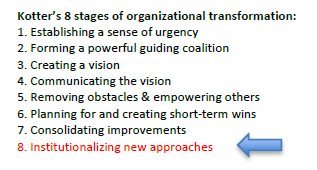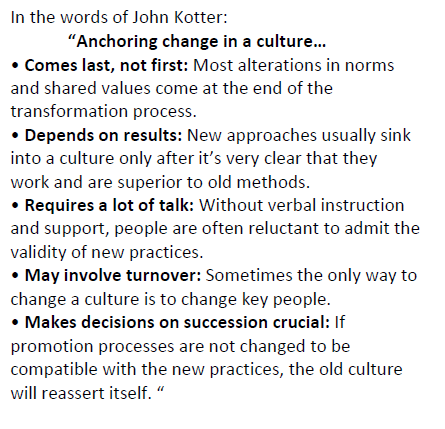In my series, “Putting the Management Back in Change,” I’ve been looking at what it really takes for companies to successfully institutionalize sustainability and truly be “green firms.” I’ve been using Harvard business guru John Kotter’s 8 step model for organizational change as a framework, but I use it to focus on sustainability initiatives. Previously, I introduced the topic and discussed the need to create a sense of urgency, build guiding coalitions to create buy-in and grow momentum, develop a strong vision of where the company is headed, communicate the vision effectively, address barriers that could derail momentum, achieve short term wins, and build on short term wins. In this last installment, I’m going to focus on the most important aspect: culture change and making this effort part of the company’s DNA.
Culture. It’s something we understand intuitively, but rarely focus on explicitly. At a gut level we know if a company has a “good” or “bad” culture but we don’t stop to figure out what makes the culture what it is. What does it mean to intentionally change culture over time and why would you do that? For organizations that are institutionalizing sustainability, and have been implementing widespread changes to systems and processes (as discussed in earlier articles), nothing will make those changes “stick” if culture isn’t addressed. Culture is the manifestation of shared values and behavior. It’s a set of common feelings about what matters and how we should act. If people are not united by a shared connection through culture, all previous efforts will disintegrate. As Kotter says, you need to “use the power of culture to make transformation stick”.
Many sustainability champions are sensitive to culture and aware that it’s an issue. They often think that culture needs to be addressed first – but that is a mistake. Culture is “squishy”. You can’t just grab on to it and re-shape it. You need to know what to grab and where to push. It needs to be defined in the context of your company through all of the change activities you engage in up to this point.
There are two key elements that make or break the effort to institutionalize the changes necessary to make a sustainability program work. The first is a deliberate effort to help people understand how the new approaches, behaviors and attitudes have helped improve performance. Left on their own, people don’t connect the dots – or they connect them incorrectly. For example, you may have a client who is really gung-ho about sustainability, highly committed and not afraid to spend a little more. It would be easy to attribute all of the success achieving high performance on this project to that external circumstance and not understand that 60% of what was achieved could be achieved and every project through your new methodology or rigorous integrative design process. This may take some time and effort, but it significantly impacts the outcome. The second element is a focus on the next generation of top management to ensure that they have really bought in to the new approach. This needs to be evaluate prerequisite for promotion. One resistant person in the upper levels can undermine years of hard work. This is also a reason why top and middle management really need to be part of the change efforts over time, and not just watching from the sidelines. It’s not enough to be neutral; leaders need to be change champions. There may even be a need to encourage people to leave who are no longer aligned with the company commitment.
Trying to change norms and values before you have created the new way of doing things does not work. The vision can articulate a new culture and you can create new behaviors that reflect that but those behaviors won’t become ingrained until the end of the process. Integrative design is a good example. If effective collaboration is an important value, clear expectations will be communicated and new processes will be put in place to institutionalize better interactions and analysis on projects. People then have an opportunity to see how project performance improves as a result and can track data that supports that success. Once people can understand what it means to behave in this way, become more comfortable with the new methodology and begin to believe in it, effective collaboration is more likely to become widespread and part of the companies way of doing things
Aligning the old, existing culture with the new, desired culture can be subtle, a matter of grafting one to another. Or it can be a matter of wholesale reinvention, depending on where you start. Both are challenging in different ways. Wholesale reinvention might require changes in leadership or reporting structure, or may not be possible at all. Most of the time, it’s more subtle, more about clarifying expectations and defining specific outcomes and actions. The challenge in this case, as Kotter puts it, becomes one of “grafting the new practices onto the old roots, while killing off the inconsistent pieces”. You can tell that something is really embedded in a culture if – when people deviate from new behavior – their peers find ways of pushing them back to the new norm.
This doesn’t mean you ignore culture until you do everything else! The better you understand the existing culture, the more effective you can be with your early efforts; the more easily you can figure out how to create a sense of urgency, how to create a guiding coalition, how to shape the vision, etc. For example, if your firm is a “bottom line only” culture, where profit has been more important than employee satisfaction or environmental impact, promoting a sense of urgency around climate change will likely fail. Focus instead on efficiency and profitability that will resonate with the group yet still lead to your desired outcome.
It’s also important to realize that when the existing culture is incompatible with the changes that need to be made, and the inconsistency isn’t confronted, things will fall apart. This is another reason to consider culture at the outset of a sustainability change management effort. If a large company with multiple offices has always been “entrepreneurial” (translation, every office does its own thing!) and suddenly there is a desire to introduce a particular project delivery methodology or professional development program – it will be an uphill battle! The adoption of the 2030 Commitment is a great example – large firms that are decentralized now need to impose a consistent way of tracking and reporting their data, not to mention having to figure out how to design projects to a consistently higher level of performance.
In the final analysis, change sticks when it becomes “the way we do things around here,” when it seeps into the bloodstream of the organization. Until new behaviors are rooted in social norms and shared values, they are subject to degradation as soon as the pressure for change is removed.
What Works ?
- Not stopping at step 7— it isn’t over until the changes have roots
- Using new employee orientation to compellingly show recruits what the organization really cares about
- Using promotions to place people who act according to the new norms into influential and visible positions
- Telling vivid stories over and over about the new organization, what it does, and why it succeeds. This engages people at an emotional level which makes them more committed.
- Making absolutely sure you have the continuity of behavior and results that help a new culture grow
What Does Not Work ?
- Relying on a boss or a compensation scheme, or anything but culture, to hold a big change in place
- Trying to change culture as the first step in the transformation process.
In a short article, everything may sound a bit too simplistic or easy. In reality, even successful change efforts are messy and full of surprises throughout the process. As Kotter says, “just as a relatively simple vision is needed to guide people through a major change, so a vision of the change process can reduce the error rate. And fewer errors can spell the difference between success and failure.” We hope this series of articles has provided guideposts to help you navigate change in your own organization – and at the very least, has helped you see that becoming a truly ‘green’ firm is not about how many LEED projects you have in your portfolio, but about intentional efforts to manage change at all levels of the organization and in its systems, processes and culture! Good luck in your continued efforts and we are here to answer questions or coach you along the way.

